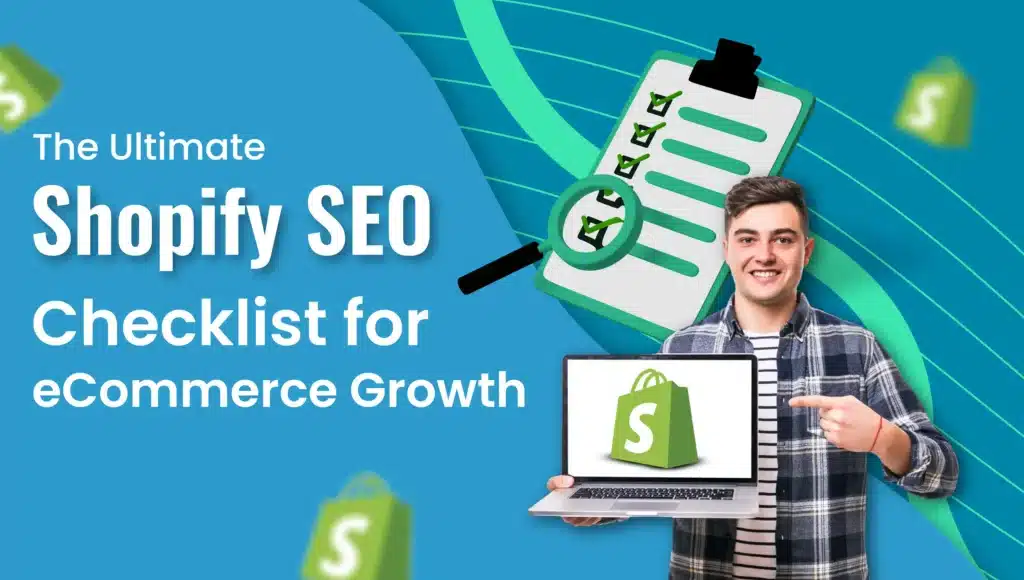In 2025, over 63% of Shopify stores still struggle to rank on page one of Google. Meanwhile, the top 3% of stores capture 85% of all clicks—without spending on ads.
If your Shopify store isn’t optimized for search, you’re leaving serious revenue on the table. This Shopify SEO checklist—backed by our real-world case studies, industry data, and proven frameworks—shows you exactly how to fix that.
Shopify SEO Trends Shaping 2025
Why is Shopify SEO evolving so fast? Simple: Google is changing, and so is consumer behavior. Shopify merchants who once ranked with basic keyword stuffing are now buried beneath AI-generated snippets, product carousels, and zero-click answers.
Let’s break down what’s shaping Shopify SEO in 2025:
🔍 1. AI-Powered SERPs Are Reshaping Traffic Distribution
- Google’s Search Generative Experience (SGE) is rewriting how results appear.
- Featured snippets and AI cards are stealing clicks from traditional blue links.
In fact, 72% of marketers in Q1 2025 used AI SEO tools—and saw an average 45% lift in rankings.
📱 2. Mobile-First Indexing Is Mandatory
With over 87% of Shopify traffic coming from mobile, Core Web Vitals like LCP, FID, and CLS now directly impact your organic visibility.
📦 3. Structured Data = Richer Results
- Adding product, review, and FAQ schema makes your listings stand out.
- Stores using structured data saw a 36% increase in CTR (Zellyo Digital Analytics, March 2025).
🗣️ 4. Voice & Zero-Click Searches
People are asking questions like “What’s the best handmade gift under $30?”—and Google is answering without a single click. Shopify stores need to optimize for conversational search and FAQ schema.
3-Step Shopify SEO Checklist to Boost Traffic Fast
Here’s the exact 3-step Shopify SEO framework we use at Zellyo Digital to drive traffic, rankings, and ROI for our clients.
✅ Step 1: Fix Technical SEO for Shopify
Keyword Focus: Shopify SEO audit, Shopify technical SEO
A high-ranking store starts with technical cleanliness. Google can’t rank what it can’t crawl.
Here’s what to check:
- 🔧 PageSpeed: Use Google PageSpeed Insights to compress images, enable lazy loading, and reduce JavaScript.
- 🧭 Canonical Tags: Prevent duplicate content across product variants.
- 🌐 Sitemap & Robots.txt: Shopify auto-generates these—verify they’re correct.
- 🛠️ 301 Redirects: Clean up broken or outdated URLs via Shopify admin > Navigation > URL Redirects.
Pro tip: Use tools like Screaming Frog to spot hidden crawl issues in collection pages or faceted navigation.
✅ Step 2: On-Page SEO That Converts
Keyword Focus: Shopify on-page SEO, optimize Shopify product pages
Ranking is half the battle—conversion is the war.
Here’s your on-page SEO formula:
For Every Product Page:
- Title Tag: Include your primary keyword (max 60 characters).
- Meta Description: Use persuasive copy + a secondary keyword.
- H1: Match your product title exactly.
- Alt Text: Every image must have keyword-relevant alt tags.
- URL Slug: Short and descriptive (e.g., /handmade-wooden-coaster).
- First 100 Words: Sprinkle in the primary keyword naturally.
Add These for Extra SEO Power:
- 📝 Use product reviews with keywords.
- 🧩 Add FAQ sections with schema.
- 📖 Use blog links or internal content to guide customers to products.
✅ Step 3: Off-Page & Content Strategy
Keyword Focus: Shopify content strategy, Shopify backlinks
Shopify stores often ignore this, and that’s your advantage.
Here’s our 3-pronged strategy:
- Start a Blog on Shopify
Target long-tail keywords your customers use on Google (e.g., “best skincare gifts for mom”). Use Clearscope or SurferSEO to map out keyword density and structure. - Build Backlinks
Reach out to:- Niche bloggers
- Journalists (via HARO or Terkel)
- Suppliers & partners
- Leverage Influencer UGC
Encourage influencers to create videos or blogs that link to your store. Offer a unique discount code for their audience.
Pro Tip: Use Ahrefs to track backlinks. One quality backlink to your homepage can boost your product pages’ authority via internal linking.
Case Study: How Zellyo Scaled a Niche Shopify Brand by 312%
“We had under 100 visitors a day. After Zellyo’s SEO revamp, we hit 17,000 in just three months.”
— Mira Khalid, Founder of CraftNest Co.
🛒 Background
CraftNest Co. sold handmade artisanal crafts but had no SEO setup. Shopify was installed with default meta tags, no blog, and slow product pages.
🛠️ Our Strategy
- Performed a full Shopify SEO audit
- Fixed technical issues: LCP dropped from 4.2s → 1.7s
- Added schema: reviews, FAQs, breadcrumbs
- Published 8 long-form blog posts on craft-related keywords
- Built 15 backlinks through outreach and partnerships
📈 Results (90 Days)
| Metric | Before | After |
| Organic Traffic | 94/day | 17,000/month |
| Top 10 Keywords | 2 | 47 |
| Conversion Rate | 1.3% | 2.6% |
| Time on Site | 38s | 1m 47s |
This growth came without a single paid ad.
Insights from Industry Leaders on Shopify SEO
📊 Gartner 2024:
“70% of eCommerce leaders plan to increase investment in technical SEO and AI-driven content creation by 2025.”
🧠 Forrester:
“User-first, schema-enriched content now serves as online retailers’ most reliable ranking signal.”
🧰 Zellyo Digital Take:
Use keyword clustering + schema + rich content to dominate Shopify’s competitive niches.
Shopify SEO FAQs: What Store Owners Ask Most
🧠 How do I improve my Shopify SEO?
Start with technical SEO fixes, optimize your product pages, and build content and backlinks.
🧠 Is Shopify bad for SEO?
No, but it has limitations. With some customization and third-party tools, it can outperform other platforms.
🧠 What is the best SEO app for Shopify?
Smart SEO, Plug in SEO, and Yoast for Shopify offer schema, audits, and real-time suggestions.
🧠 Does Shopify allow meta tags?
Yes. You can edit title tags and meta descriptions for every page, product, and collection.
🧠 How long does it take to see SEO results?
Typically 2–4 months. Backlinks and regular content publishing can speed this up.
🧠 Does blogging help Shopify SEO?
Absolutely. Blog posts drive long-tail traffic, increase topical authority, and support backlinks.
🧠 Can I do SEO on Shopify without apps?
Yes, but apps save time. Manual SEO requires editing code and using Google’s tools.
🧠 How do I rank higher for product pages?
Use keywords in all the right places, include reviews, and add product schema.
Final Thoughts on Shopify SEO Success in 2025
If 2024 was about visibility, 2025 is about performance. Shopify SEO today means:
- Optimizing every product and page for search and speed
- Creating meaningful content around buyer intent
- Building a strong link ecosystem on and off your site
Want help implementing all of this?
Zellyo Digital offers done-for-you Shopify SEO audits and growth frameworks that move the needle fast.


